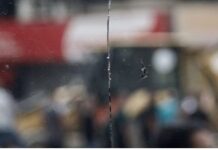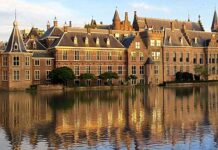Simona Foltyn
The Guardian / September 6, 2024
Beqaa Valley – Known for its wineries and Roman temples, and as the home of Hezbollah, the Beqaa has become a theatre of war again.
On a recent morning near the town of Nabi Chit in Lebanon’s eastern Beqaa region, a dozen men were clearing away debris. Israeli jets had thundered through the valley a week earlier, the second such raid in three days. The explosions turned the night sky red, yellow and orange, and filled the air with the smell of dust and gunpowder.
“They hit Nabi Chit because our village is the mother of the resistance,” said Mohammed al-Moussawi, an ardent supporter of Hezbollah, the Shia militant group, political party and social movement known here as the resistance. He stood on the ground-floor terrace of his house in front of a pile of rubble and a twisted metal awning. The windows were blown out, the facade pockmarked with shrapnel.
A neighbour was killed in the strikes. Moussawi’s grandson Hussain was among the 20 injured and was rushed to hospital after shattered glass cut his face. “He is four years old and already understands that Israel is the enemy who violates Arab land. What do you think he will be when he grows up?” Moussawi said.
The Israel Defense Forces (IDF) declined to comment on the casualties, but in an earlier statement said fighter jets had targeted a weapons depot and air defence system on the night of 21 August, causing secondary explosions. Hezbollah, local authorities and witnesses insisted there had been a direct hit on civilian homes.
While Lebanon’s southern villages have borne the brunt of cross-border fire in a thus far limited war of attrition, the recent strikes on the Beqaa could signal a widening of the war to the country’s east. The valley is known for its fertile soil, wineries and Roman temples, which until recently drew international tourists.
As the region’s fault lines risk tearing open, another aspect of the Beqaa’s history is taking centre stage.
Dubbed the “reservoir of the resistance,” the Beqaa is Hezbollah’s bastion of support and a depository for weapons along a strategic corridor that connects Hezbollah to allies in Syria, Iraq and Iran.
“We consider the south to be the first line of defence for Lebanon, and we in the Beqaa are the second line of defence,” said the mayor of Nabi Shayt’s Hezbollah-run municipality, Hassan al-Moussawi [Moussawi is one of the most common names in Nabi Chit and there are no close family ties between the interviewees]. Hezbollah enjoys backing from the Beqaa’s powerful tribes and draws its fighters from the area’s predominantly Shia population.
The Beqaa is the birthplace of Hezbollah and several of its leaders. A short walk downhill from the municipality lies the ornate shrine of Abbas al-Moussawi, the Shia cleric who co-founded Hezbollah in 1982 with the help of Iran’s Revolutionary Guards to fight against Israel’s occupation of Lebanon. The Beqaa was the location of the first training camp and served as a rear base as Hezbollah battled Israeli troops in the south until the latter withdrew in 2000. During the next war, in 2006, Israel bombed one of the main bridges leading to the valley to cut off supply lines.
In recent weeks, the Beqaa has again become a theatre of war. For the first time since October, when Hezbollah entered the conflict in support of its ally Hamas, it used the valley on 25 August to launch drones towards Israel, its secretary general, Hassan Nasrallah, revealed in a speech that day. The drones were part of the long-anticipated response to Israel’s assassination of Fuad Shukr, the most senior Hezbollah commander to be killed in air and drone strikes that have left more than 400 Hezbollah combatants dead.
Nasrallah admitted that Shukr’s killing was a “big loss”, one that is particularly felt in Nabi Chit, his home town. The use of the Beqaa as a launching pad was a symbolic act to avenge his death as much as a strategic message that Hezbollah was ready to activate its rear base. “The military message Sayyid Nasrallah sent is that we are for peace, not for war, but if war is imposed on us, we are ready to use advanced weapons,” Moussawi, the mayor, said.
Hezbollah’s estimated arsenal of 150,000 rockets and missiles is mostly supplied by Iran, which has remained the group’s main backer even as it evolved from its insurgent roots to become the de facto state in Shia-majority areas, such as the Beqaa. Across Nabi Chit, posters pay tribute to Iranian leaders, such as the late general Qassem Suleimani, who is credited with strengthening Iran’s network of regional allies. Despite this overt veneration of Iranian leadership, many here do not see Hezbollah as an Iranian proxy.
“The west thinks there’s a leader and a follower, that Iran gives an order and we fire,” said a different Mohammed Moussawi, the spokesperson of the Abbas al-Moussawi shrine, which features a large poster of Iranian leaders next to the tomb. “The relationship is an alliance where decisions are taken through consultation. If Iran says, ‘Let’s bomb Tel Aviv,’ but it’s not in Hezbollah’s interest, it won’t happen.”
Israel and many western nations have designated Hezbollah a terrorist organization. In a statement that followed the strikes on Nabi Chit, the IDF said: “The Hezbollah terrorist organization operates from within civilian infrastructure, brutally exploiting the Lebanese civilian population.”
But far from feeling exploited, people in Nabi Chit rallied around Hezbollah after the strikes. “I am with the resistance because of the injustice I experienced,” said Moussawi, the supporter whose house was damaged.
He was arrested by the Israeli army in 1984, when it occupied Lebanon. During the interrogation, Israeli officers pulled out all his teeth, he said, pausing to pop out his implants and reveal his toothless jaws. Upon his release, Moussawi joined Hezbollah. Now aged 60, he is retired, but his two sons followed in his footsteps. His grandson Hussain would probably become the family’s third generation to fight in Hezbollah’s ranks.
One reason for people’s deep affiliation with Hezbollah is religion. The Beqaa is steeped in Shia doctrine. The Moussawi family traces its origins to the seventh Shia imam, Musa al-Kadhim, a successor to the prophet Muhammad. The struggle against injustice is a tenet of the Shia faith and evoking it has allowed Hezbollah to cast its participation in this conflict as a broader struggle against Israel’s encroachment on Palestinian and Lebanese land.
Such views are further buoyed by anti-occupation beliefs that date back centuries. The Beqaa’s tribes pride themselves on having resisted invaders during Ottoman and French rule and see Israel as the epitome of colonialism.
“I stand with the Palestinians because if the Palestinians are gone, Israel will take on Lebanon next,” said Sheikh Midhat Zeaiter, chief of most powerful tribe in the Beqaa.
He sat on the porch of the family home nestled on a hillside near the city of Baalbek. The village was surrounded by cannabis fields, which have become the valley’s main source of income, gradually replacing other, less profitable and more water-intensive crops in what used to be known as Lebanon’s bread basket.
In return for the tribes’ loyalty, Hezbollah draws local officials and members of parliament from their ranks and allows cannabis cultivation, even though the drug trade runs counter to its ideology. “The tribes and Hezbollah share the same principles of armed resistance,” said the sheikh’s son Mohar Zeaiter. “We can differ on a hundred other issues, but not when it comes to fighting Israel.”
Simona Foltyn – Beqaa Valley, Lebanon












